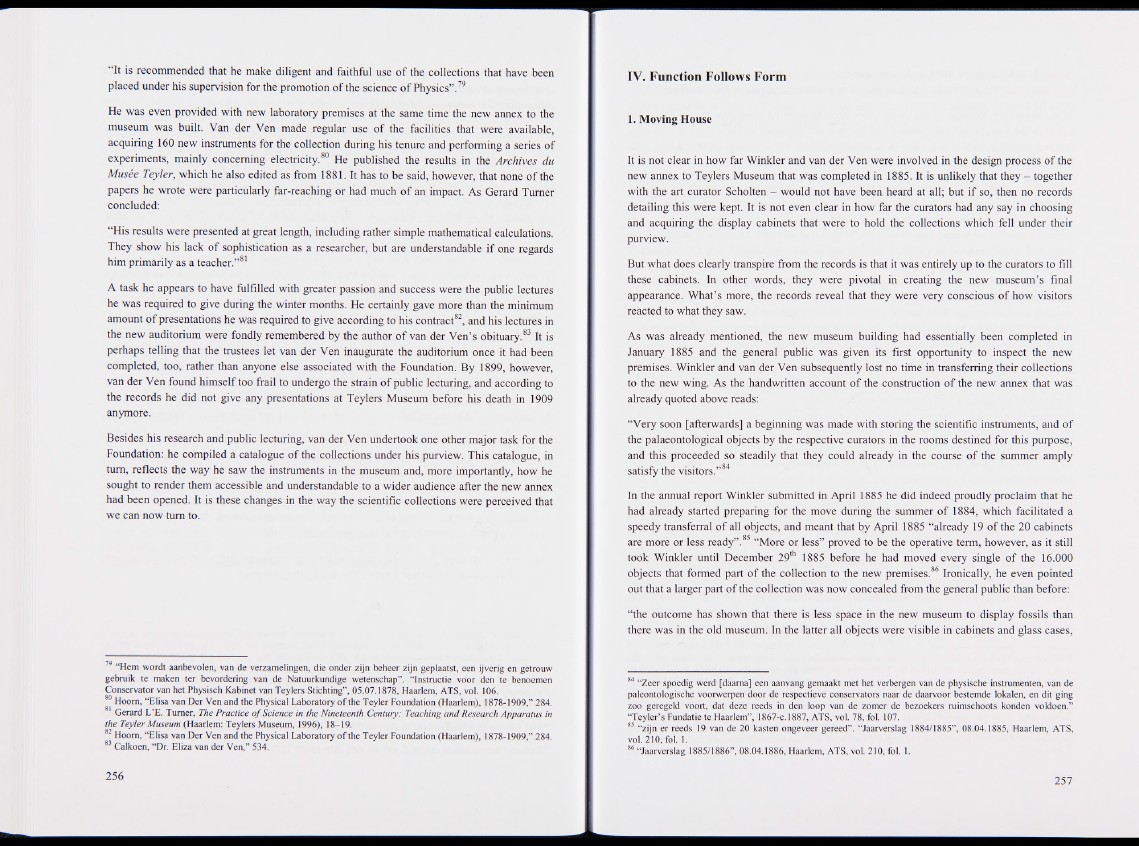
It is recommended that he make diligent and faithful use of the collections that have been
placed under his supervision for the promotion of the science of Physics”.79
He was even provided with new laboratory premises at the same time the new annex to the
museum was built. Van der Ven made regular use of the facilities that were available,
acquiring 160 new instruments for the collection during his tenure and performing a series of
experiments, mainly concerning electricity.80 He published the results in the Archives du
Musée Teyler, which he also edited as from 1881. It has to be said, however, that none of the
papers he wrote were particularly far-reaching or had much of an impact. As Gerard Turner
concluded:
“His results were presented at great length, including rather simple mathematical calculations.
They show his lack of sophistication as a researcher, but are understandable if one regards
him primarily as a teacher.”81
A task he appears to have fulfilled with greater passion and success were the public lectures
he was required to give during the winter months. He certainly gave more than the m in im um
amount of presentations he was required to give according to his contract82, and his lectures in
the new auditorium were fondly remembered by the author of van der Ven’s obituary.83 It is
perhaps telling that the trustees let van der Ven inaugurate the auditorium once it had been
completed, too, rather than anyone else associated with the Foundation. By 1899, however,
van der Ven found himself too frail to undergo the strain of public lecturing, and according to
the records he did not give any presentations at Teylers Museum before his death in 1909
anymore.
Besides his research and public lecturing, van der Ven undertook one other major task for the
Foundation: he compiled a catalogue of the collections under his purview. This catalogue, in
turn, reflects the way he saw the instruments in the museum and, more importantly, how he
sought to render them accessible and understandable to a wider audience after the new annex
had been opened. It is these changes in the way the scientific collections were perceived that
we can now turn to.
79 “Hem wordt aanbevolen, van de verzamelingen, die onder zijn beheer zijn geplaatst, een ijverig en getrouw
gebruik te maken ter bevordering van de Natuurkundige wetenschap”. “Instructie voor den te benoemen
Conservator van het Physisch Kabinet van Teylers Stichting”, 05.07.1878, Haarlem, ATS, vol. 106.
Hoorn, “Elisa van Der Ven and the Physical Laboratory o f the Teyler Foundation (Haarlem), 1878-1909,” 284.
Gerard L’E. Turner, The Practice o f Science in the Nineteenth Century: Teaching and Research Apparatus in
the Teyler Museum (Haarlem: Teylers Museum, 1996), 18-19.
82 Hoom, “Elisa van Der Ven and the Physical Laboratory o f the Teyler Foundation (Haarlem), 1878-1909,” 284.
83 Calkoen, “Dr. Eliza van der Ven,” 534.
IV. Function Follows Form
1. Moving House
It is not clear in how far Winkler and van der Ven were involved in the design process of the
new annex to Teylers Museum that was completed in 1885. It is unlikely that they - together
with the art curator Scholten - would not have been heard at all; but if so, then no records
detailing this were kept. It is not even clear in how far the curators had any say in choosing
and acquiring the display cabinets that were to hold the collections which fell under their
purview.
But what does clearly transpire from the records is that it was entirely up to the curators to fill
these cabinets. In other words, they were pivotal in creating the new museum’s final
appearance. What’s more, the records reveal that they were very conscious of how visitors
reacted to what they saw.
As was already mentioned, the new museum building had essentially been completed in
January 1885 and the general public was given its first opportunity to inspect the new
premises. Winkler and van der Ven subsequently lost no time in transferring their collections
to the new wing. As the handwritten account of the construction of the new annex that was
already quoted above reads:
“Very soon [afterwards] a beginning was made with storing the scientific instruments, and of
the palaeontological objects by the respective curators in the rooms destined for this purpose,
and this proceeded so steadily that they could already in the course of the summer amply
satisfy the visitors.”84
In the annual report Winkler submitted in April 1885 he did indeed proudly proclaim that he
had already started preparing for the move during the summer of 1884, which facilitated a
speedy transferral of all objects, and meant that by April 1885 “already 19 of the 20 cabinets
are more or less ready”. “More or less” proved to be the operative term, however, as it still
took Winkler until December 29' 1885 before he had moved every single of the 16.000
objects that formed part of the collection to the new premises.86 Ironically, he even pointed
out that a larger part of the collection was now concealed from the general public than before:
“the outcome has shown that there is less space in the new museum to display fossils than
there was in the old museum. In the latter all objects were visible in cabinets and glass cases,
4 “Zeer spoedig werd [daama] een aanvang gemaakt met het verbergen van de physische instrumenten, van de
paleontologische voorwerpen door de respectieve conservators naar de daarvoor bestemde lokalen, en dit ging
zoo geregeld voort, dat deze reeds in den loop van de zomer de bezoekers ruimschoots konden voldoen.”
“Teyler’s Fundatie te Haarlem”, 1867-C.1887, ATS, vol. 78, fol. 107.
“zijn er reeds 19 van de 20 kästen ongeveer gereed”. “Jaarverslag 1884/1885”, 08.04.1885, Haarlem, ATS,
vol. 210, fol. 1.
86 “Jaarverslag 1885/1886”, 08.04.1886, Haarlem, ATS, vol. 210, fol. 1.